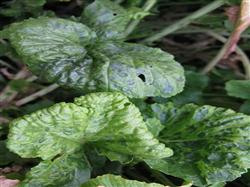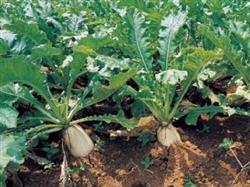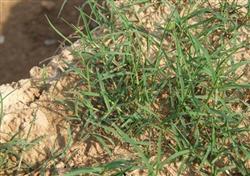Radish planting: what diseases does autumn radish have?

What diseases does autumn radish have? Please introduce the common diseases of autumn radish, such as virus disease, soft rot, downy mildew and so on. The detailed introduction can refer to the following: symptoms of downy mildew: the disease is serious in the middle and later stage, mainly harming leaves. The disease extends from the lower leaves to the upper leaves, and the irregular chlorotic macula appears at the initial stage, and then expands into polygonal yellowish brown spots. When wet, mildew grows on the back or both sides of the leaf, and in severe cases, the disease spot causes the leaf to dry up. Incidence regularity: the disease is a fungal disease. When the temperature is about 16 ℃, the relative humidity is higher than 70%, the variety is susceptible to the disease and the bacterial source exists, the disease is easy to spread rapidly. In general, early sowing, poor resistance of varieties, too close planting, high humidity in the field, extensive management and serious disease in continuous cropping land. Control methods: rotation with non-cruciferous vegetables for more than 2 years; removal of diseased plant residues and centralized treatment; timely topdressing and watering to enhance resistance. At the initial stage of the disease, spray control with 72.2% Purek water agent 600 times 800 times, or 75% chlorothalonil wettable powder 500 times, or 64% poison alum 500 times, once every 7 to 10 days, 2 times for 3 times. Symptoms of soft rot: it mainly harms roots, leaves and petioles. Root infection, often begins at the root tip, the initial brown water immersion-like soft rot, and then gradually spread upward, so that the heart soft rot fester. The leaves and petioles were infected and also showed water-immersed soft rot. After drought, the disease stopped spreading and new leaves appeared on the root tip. The boundary between the disease department and the health department is clear. There is often brown juice oozing, causing the whole radish to turn brown and soft rot. Incidence regularity: the disease is a bacterial disease, the bacteria mainly exist in the soil, invaded by the wound. The disease is easy to occur at 25 ℃ ~ 30 ℃. Control methods: rotation with non-cruciferous vegetables for more than 3 years; avoid wound as far as possible; adopt ridge cultivation or high box deep trench planting. At the initial stage of the disease, 72% agricultural streptomycin sulfate wettable powder was sprayed with 3000 / 4000 times of agricultural streptomycin sulfate or 600 times of 12% green copper EC, once every 10 days and twice in succession. Symptoms of virus disease: the disease can occur at the seedling stage, the diseased plant is short, and the leaves are wrinkled, uneven, twisted or yellow-green mosaic. Disease regularity: the disease virus is mainly transmitted by insects (such as aphids, jumping beetles), and can also be transmitted by leaf friction. The disease was serious in the conditions of extensive field management, high temperature, drought, large number of aphids and jumping beetles, poor plant growth and poor disease resistance. Prevention and treatment methods: early removal of diseased plants and strengthening field management. It is necessary to spray 2000 times of imidacloprid wettable powder to control aphids, 1000 times of crystal trichlorfon to control jumping beetles, and spray 1000 times of antiviral agent Ⅰ or 20% virus A wettable powder or Zhanling Ⅱ at the initial stage of the disease, once every 10 days. Click for more radish planting techniques click to get more vegetable planting techniques
- Prev

Radish planting video picture: Baiyuchun radish cultivation
Bai Yuchun is a radish variety produced by South Korea bio Co., Ltd., which was introduced by Beijing Shinong Seedling Co., Ltd. The plant type and quality of this variety are different from Bai Yuchun and Xinbai Yuchun, and it is a good product of fleshy dense radish. It has been popularized rapidly in recent years because of its wide adaptability, fast growth rate, high yield and good marketability. 1...
- Next

Radish planting: how to control weeds when planting autumn radish?
How to control weeds when planting autumn radish? Please introduce the method from late August to early September is the sowing time of autumn and winter radish. Radish grows slowly in the early stage after emergence, the seedling body is small, and it is easy to be damaged by weeds. Especially in the frequent weather of autumn rain, the emergence and growth of weeds will seriously inhibit the growth and development of radish.
Related
- Where is it suitable to grow horseradish in China? it is expected to see the middle altitude horseradish in Alishan.
- How to prevent tomato virus disease reasonably? (Control methods included)
- Many people like to plant towel gourd on the balcony. What are the main points of this method and management?
- What crops can chili peppers be mixed with?
- Fertilization techniques and matters needing attention in Tomato
- What are the grafting techniques for peach seedlings in spring?
- Harm and control methods of root swelling disease of Chinese cabbage
- What are the pests of sweet potatoes? How to prevent and cure it?
- Symptoms, causes and Control methods of navel Rot in Tomato
- The cause of "Cucumber rotten bibcock" in Farmers' planting Cucumber and its Control Plan

